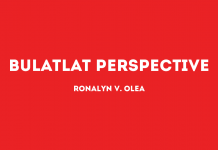THE RECENT pronouncement of Presidential Spokesperson Harry Roque shows the absence of governance amid the COVID-19 pandemic. After President Rodrigo Duterte asked for emergency powers — which includes the authority to reallocate budget – we, the Filipino people have been left to fend for ourselves.
Roque admitted there is no program for mass testing, passing on the burden to the private sector. It is impossible, said Roque, to test the entire population for COVID-19. Either he does not know or pretends not to know that mass testing refers to testing for all health workers who have exposure, for those who have symptoms, for those who had contact with COVID-19 positive and for the vulnerable population.
This begs the question “What was the two-month-long enhanced community quarantine for?”
From Day 1, experts and progressives have been calling for mass testing, pointing out that COVID-19 need not be an invisible enemy. Along with contact tracing and isolation, mass testing could suppress the spread of the virus. And for two months, we endured being locked up in our homes, as the Department of Health (DOH) vowed to increase its testing capacity.
According to DOH COVID-19 Case Tracker, as of May 19, there were 207,823 individuals tested and 224,673 total tests conducted. The figure is only 0.19 percent of the total population. In many countries, the number of individuals tested would usually account for one to two percent of the population.
Even as experts have warned that we have not yet flattened the curve, the national task force modified the ECQ in Metro Manila, the epicenter of the pandemic in the country on May 15. Giving the go-signal for businesses to resume is akin to treating workers and employees like disposables.
When thousands of workers returned to work on May 18, the national government was quick to blame citizens for not practicing physical distancing. The Duterte administration’s penchant for blaming the pasaway (disobedient) aims to absolve itself of criminal neglect.
With billions of pesos at its disposal, from the nation’s coffers and from loans incurred in our name, this government still failed to institute even the minimum standards for COVID-19 response. Of the P380-billion COVID-19 budget under the Bayanihan to Heal as One Act, it has spent P12.32 billion for health or merely 3.2 percent of the total COVID-19 allocation as of May 11, according to Citizens’ Budget Tracker.
We only have to look at the situation of our medical frontliners. According to the Alliance of Health Workers (AHW), test kits in public hospitals are out of stock. Supplies of personal protective equipment and other medical supplies are still insufficient. Until now, hospitals rely on individuals and private donations for PPE. As one health worker succinctly put it, “Hindi kami pumapasok para mamatay. Ang health workers ay pumapasok para magsilbi.” (We don’t go to work in order to die. We go to work in order to serve.)
Meanwhile, the subsidy provided to the poor could not even last for a week. Nine weeks into ECQ, only 73 percent of the target beneficiaries of social amelioration program (SAP) has been reached, according to independent estimates. Local government units had to scramble for funds to be able to cover more families.
While most Filipinos are reeling from the impacts of the lockdown, the Duterte administration is so callous that it will be spending $2 billion for attack helicopters, missiles and other military equipment.
It is escalating its war on “insurgency” in this time of pandemic. State security forces continue to kill, torture and bomb communities of farmers, indigenous peoples and other rural folk in the guise of crushing the armed revolutionary movement.
The Duterte administration is afraid of its own shadows that it has repeatedly threatened to declare martial law. The Filipino people must collectively act to protect our lives and regain our dignity. (Bulatlat.com)





